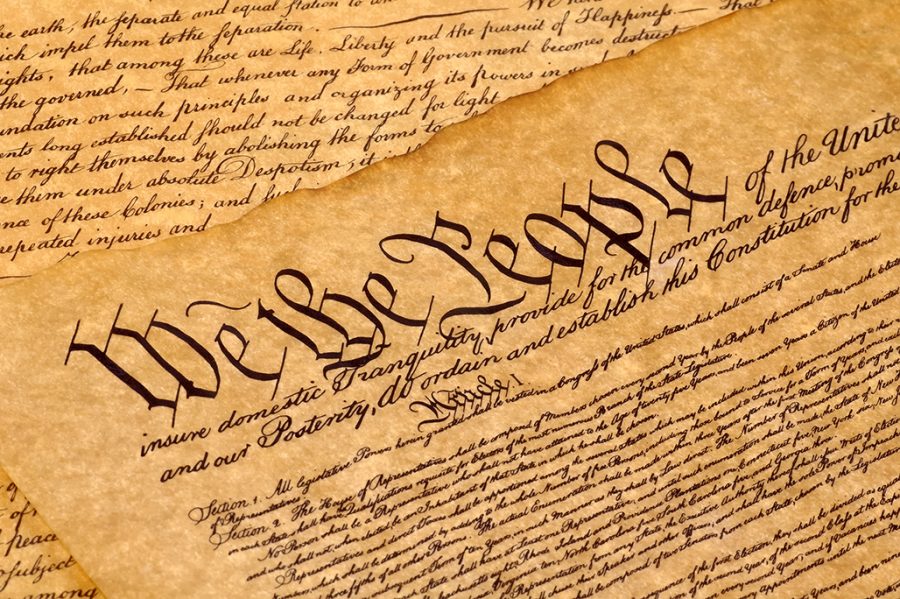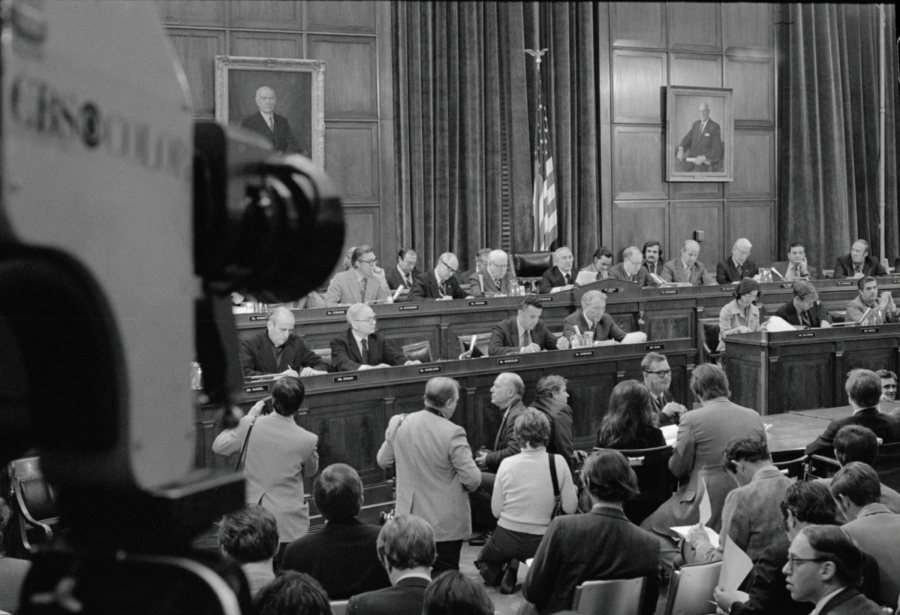Your donation will support the student journalists of Lake Forest High School. Your contribution will allow us to purchase equipment and cover our annual website hosting costs.
Saul Loeb/Getty Images (left), ABC News (right)
House Speaker Nancy Pelosi gavels in the vote for the first article of impeachment in the House of Representatives. Meanwhile, President Trump speaks at a rally in Battle Creek, MI.
President Donald J. Trump Impeached By House For Abuse of Power, Obstruction of Congress
Trump is the Third President of the United States to be Impeached
December 20, 2019
These are the times that try men’s souls, as Thomas Paine once wrote. More specifically, they try our ability to make sense of the facts. As the professional news media becomes more polarized, we at The Forest Scout feel that another resource is necessary.
This is intended to be that resource, one that provides the facts and baseline endeavors to make sense of them. Our sources and our predictions will inevitably be biased — everything is — but we hope that the end result can be an unbiased depiction of what exactly led to the impeachment of President Donald Trump by the House of Representatives on Wednesday.
As always, please contact us at [email protected] to point out any mistakes we may have made. Comments are welcome, and please review our editorial policy for any additional clarification.
On The Impeachment of President Donald Trump
See the full text of the impeachment resolution at congress.gov.
On Wednesday, Dec 18, 2019, at 7:34 PM, the 45th President of the United States, Donald J. Trump, was impeached by the House of Representatives under two distinct articles of impeachment: one accusing him of abuse of power, and the other of obstruction of Congress. See the next section for a detailed explanation of what that actually means.
House votes for the first article included 230 in favor, and 197 against. The votes for article two stood at 229-198. These votes were almost completely along party lines, with unanimous opposition from Republicans, and only two opposing Democrats. Representative and Presidential candidate Tulsi Gabbard (D-HI) voted “present.” These results are hardly surprising, as the rhetoric that surrounded the inquiry consisted almost entirely of heated accusations of partisan motives.
Article one surrounds the notion that President Trump “solicited the interference of a foreign government” with Ukraine in order to benefit his reelection campaign. The article alleges that the President requested that Ukraine announce an investigation of former Vice President and Democratic Presidential candidate Joseph Biden, and of a theory promoted by Russia that Ukraine interfered in the 2016 Presidential election. President Trump allegedly did this over a phone call with Ukranian President Volodymyr Zelenzky. See the transcript at FOX News or The Washington Post; both versions are identical.
Upon Ukraine’s refusal to do these things, the President briefly withheld $391 million in taxpayer funds appropriated to provide “vital” military assistance to Ukraine in opposition of Russian aggression. Democrats consider this to be a method of bargaining, but President Trump denies this accusation.
The second article surrounds the executive branch’s alleged defiance of the impeachment process, with directives from the President to defy lawful subpoenas and “withhold the production” of crucial documents. Trump and his supporters justify these actions in their belief that the investigation required an overstep in releasing important information from the executive branch.
Upon Wednesday’s vote, these two charges were approved by a Democrat-majority House of Representatives as the third presidential impeachment in the 243-year history of the United States, after Andrew Johnson in 1868 and Bill Clinton in 1998.
On Impeachment
The structure of the impeachment process stems from several distinct parts of the United States Constitution. Let’s run through them.
This section is an explanation of the impeachment process. Staff Writer Kiera Burns’ earlier piece provided a brief overview of impeachment, but this is the real deal. Those seeking to better understand the impeachment of President Trump should read on; those pressed for time should skip to the next section.
* * *
“The House of Representatives shall chuse [sic] their Speaker and other Officers; and shall have the sole Power of Impeachment”
—Section 2, Article I
“The Senate shall have the sole Power to try all Impeachments. When sitting for that Purpose, they shall be on Oath or Affirmation. When the President of the United States is tried, the Chief Justice shall preside: And no Person shall be convicted without the Concurrence of two thirds of the Members present”
“Judgment in cases of Impeachment shall not extend further than to removal from Office, and disqualification to hold and enjoy any Office of honor, Trust or Profit under the United States: but the Party convicted shall nevertheless be liable and subject to Indictment, Trial, Judgment and Punishment, according to Law”
—Section 3, Article I
“The President… shall have Power to grant Reprieves and Pardons for Offenses against the United States, except in Cases of Impeachment”
—Section 2, Article II
“The President, Vice President and all civil Officers of the United States, shall be removed from Office on Impeachment for, and Conviction of, Treason, Bribery, or other high Crimes and Misdemeanors”
—Section 4, Article II
* * *
These Constitutional provisions establish impeachment as the sole province of the House. No other organ of government has any role whatsoever — not the Senate, not the President, not the Supreme Court.
Impeachment, however, is not the whole story. It is, in essence, a mechanism for the House of Representatives to accuse a President of treason, bribery, or “other High Crimes and Misdemeanors.” (There is no precise definition of any of these terms, but Andrew Johnson was impeached for violating the Tenure of Office Act [which was ruled unconstitutional by the Supreme Court in 1926] and Bill Clinton was impeached for perjury and obstruction of justice. It is therefore safe to say that the definition is fluid.)
When the House wants to impeach someone, it does so with “articles of impeachment.” These are special House Resolutions that formally accuse the President of committing treason, bribery, or some other high crime or misdemeanor. As with all House Resolutions, a simple majority is enough to secure passage and thereby impeachment.
Just as an accusation must be tried before a court of law, so too must there be an impeachment trial. That’s where the Senate comes in; the Chief Justice presides as various witnesses are called to testify, and the Senate investigates the charges. The Senators act as jurors; if two thirds vote to convict the President of an accusation made in an article of impeachment, then the President is considered convicted — but not necessarily removed from office. We’ll explain.
Remember the part about “Judgement in cases of Impeachment shall not extend further than…” from Section 3, Article I? This is where that kicks in. The jury is still out (see what we did there?), but there are valid arguments for the notion that the Senate may take any of the following courses of action upon conviction:
-
- remove a convicted official from office,
- disqualify them from ever again holding office under the United States federal government (in the case of the President, this would disqualify them from standing for election),
- both,
-
- or neither.
Section 3 establishes an upper limit on punishment for conviction of removal from office and disqualification from future office; this is not a requirement that both sanctions be levied at the same time, though the simpler language of Section 4, Article II may contradict that.
The Senate is inclined to give itself as much power as it can; in the past it has voted separately on removal and disqualification. Legal scholars, though, are still very much in debate over the meaning of these two sections and whether or not the Senate could, for example, convict President Trump of the charges without punishing him in any way. Of course, no President has ever been convicted.
So What Happens Next?
With impeachment charges now formally passed by the House, the focus shifts to the Senate, where a trial will determine the fate of President Trump.
The results, however, seem all but scripted, as the trend of harsh partisanship seen in the House during the impeachment vote will almost certainly continue in the Republican-majority Senate. Assuming that every Democrat in the Senate votes to convict the President of these charges — and that is far from certain — they will need to convince 20 Republicans to take their side. The prospects of Team Blue pulling that particular political stunt seem extraordinarily unlikely; Senate Majority Leader Mitch McConnell has said numerous times that a conviction would be an unprecedented scenario given the partisanship of this case.
Ye Shall Know the Past and the Past Shall Set You Free
The only impeachment inquiry in American history to be bipartisan in any way, shape, or form was that into Richard Nixon during the first half of 1974. The Watergate scandal that set the whole affair in motion was two years old at the time. The committee began investigating in early February of 1974; it approved three articles of impeachment at the end of July. The investigation therefore lasted just under eight months, in stark contrast with the three months of the present inquiry. Then again, there was no formal impeachment inquiry into President Andrew Johnson whatsoever.
Republicans stonewalled the inquiry at first. But by the time the committee adopted its articles of impeachment and sent them to the full House for approval, 6 out of 17 Republican committee members had joined ranks with the Democrats. Shortly thereafter, Nixon was ordered by the Supreme Court to hand over tapes relating to the Watergate scandal; his remaining Republican support in Congress evaporated overnight.
The Nixon impeachment process was never finished, but it remains arguably the shining example of how American impeachment is supposed to work. A bipartisan majority emerged over time, and it became overwhelming once incontrovertible evidence became public. That sequence of events has not played out here, for reasons that scholars will debate decades hence.
In Conclusion
The coming weeks will be crucial, and the results will have lasting repercussions (for better or for worse) on our present political climate and our political system as a whole.
All this as the daylight dwindles and the 2020 Presidential election approaches.


